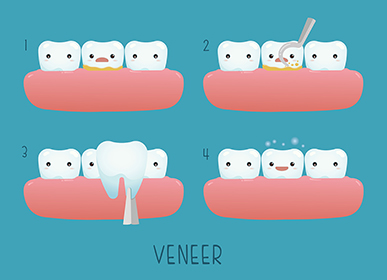Veneers are very thin pieces of durable, tooth shaped porcelain that are custom made (for shape and color) by a professional dental laboratory. They are bonded onto the front of teeth to create a beautiful and attractive smile.
Veneers can completely reshape your teeth and smile. They can often be alternatives to crowns and the ideal solution in treating many dental conditions.
As with most dental restorations, veneers are not permanent and may someday need replacement. They are very durable and will last many years, giving you a beautiful long lasting smile.
Reasons for porcelain veneers:
- Cosmetically, to create a uniform, white, beautiful smile.
- Crooked teeth.
- Misshapen teeth.
- Severely discolored or stained teeth.
- Teeth that are too small or large.
- Unwanted or uneven spaces.
- Worn or chipped teeth.

What does getting porcelain veneers involve?
Getting veneers usually requires two visits to complete the process. The teeth are prepared and a mold or impression of the teeth is taken and a shade (color) will then be chosen by you and the dentist.
On the second visit the teeth will be cleansed with special liquids to achieve a durable bond. Bonding cement is then placed between the tooth and veneer and a special light beam is used to harden and set the bond.
You will receive care instructions for veneers. Proper brushing, flossing and regular dental visits will aid in the life of your new veneers.
Freehand Bonding
This is a process of using composite resin filling materials to improve color, rotations, fractures and shape of the front teeth. This process can normally be done in one visit without the use of a lab or temporaries. Due to advances in materials, the results can be very realistic and exhibit incredible shine and lifelike colors. Advatages of this style of cosmetic care include very conservative tooth preparations, instant results, total control of shade and shape and reduction in cost because no lab fee is generated. Some limitations include long term durability, about half the time as compared to porcelain. We normally choose direct bonding for children, some teenagers, when instant results are needed or when a less expensive treatment is necessary.

